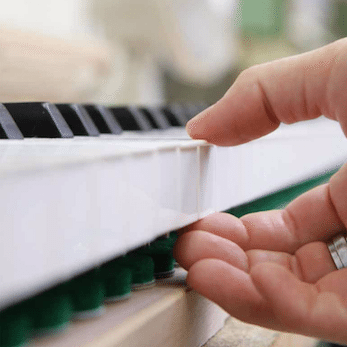
Manufacturing
At Schimmel’s state of the art facility in Braunschweig, Germany, Schimmel’s technicians have full quality control over every step in the production process.
The expressive touch and playability of Schimmel’s instruments are the result of years of exhaustive research, the expertise of Schimmel’s Master Technicians, and Schimmel’s CAPE-Technology precision (Computer Assisted Piano Engineering).
Watch the fascinating 20 minute documentary on the left about Schimmel’s superb manufacturing process.
CAPE (Computer Assisted Piano Engineering) Design Software
In the process of any piano manufacturing, one encounters mathematical relationships and the basic laws of physics. The Schimmel CAPE program takes all these factors further. CAPE opens up new dimensions in the area of piano manufacture. It enhances accuracy and optimises quality, programs the automatic machines, improves production methods, and implements results of research.
The CAPE technology encompasses;
- The experience gathered over a century of piano manufacturing
- The mathematical analysis of the art of piano manufacturing
- The knowledge of the physics of vibrating components
- The analysis of vibrating soundboards
- The calculation of the stiffnesses of cast-iron plates
- The results of measurements of the velocity of sound waves
- The interaction of wood, metal and felt
- Knowledge concerning the geometry of good keyboard and action assemblies
- Complete mastery in dealing with mass and acceleration, plus much more.


Triplex Scale
Featured in Schimmel konzert series pianos is triplex scaling. Harmonic richness of tone is achieved through the integration of the front and rear sections of the string into the production of sound. The tuneable triplex scale allows precise voicing of the partials (harmonics) for every individual note.
Through the use of the same scaling as the full size concert grand piano, all Schimmel grand pianos can achieve an element of the larger instrument’s sound.
Dynamic Bar
Computer Assisted Piano Engineering has allowed Schimmel to position a dynamic bar within the piano that allows the greatest range of sound dynamics even at pianissimo, through careful control of the vibrations of the soundboard in certain areas and at certain volume levels.
The Backbone of a Schimmel Piano
Over 230 strings serve as sound sources, each vibrating independantly. Once set into vibration by the hammer blow, they set the bridge, and in turn the sensitive soundboard, into vibration. The strings of a piano are each under tension in excess of 686 newtons / 154 lb., adding up to a grand total of 176,520 newtons / 20 tons.
This is a good reason why the cast-iron plate, the backbone of a Schimmel piano, is computer optimised with the aid of the Schimmel CAPE software.
Mass Reduced Bridge
Schimmel concert bridges produce a dynamic groove which makes these bridges lighter and the soundboard more flexible. This produces superior tonal dynamics and longer sustained notes.


Keyboards Made In Germany
Schimmel has good reason to manufacture its own keyboards – it is the vital link to the Schimmel keyboard/action assembly. The action is the complicated system of levers located above the keys. Its system must be in perfect balance in order to allow fine ppp and strong fff, fast repetition, and subtle sounding notes and harmonies. The pianist’s touch of the keyboard determines the speed and energy of the hammer in the action, contacting and energising the strings.
Details in workmanship and material are paramount if the pianist is to enjoy playing the instrument and experience rich, expanded dynamic sonority. Schimmel keyboard/action systems are examples of exclusive workmanship, regulated to discriminating standards and ideally matched to the strung back assemblies.
The Action
Each Schimmel keyboard/action assembly is a work of art and precision, made from over 10,000 pieces in grand pianos (uprights over 8,000) carefully put together and perfectly regulated by Schimmel’s master craftsmen. The original Schimmel keyboard provides intimate access to the instrument. What looks so simple at first glance, is indeed very complex.
The hammer headers are among the most important parts of the action. Schimmel uses only the best. The hammers are inspected for the properties of the felt that determine the sound (type of material and its origin, form, size, weight and felt tension). Schimmel hammer heads have the correct balance between internal stresses and resilience, to enable a pleasant, shapable tonal character throughout the entire compass of the instrument, from the softest pianissimo to the most powerful fortissimo.



